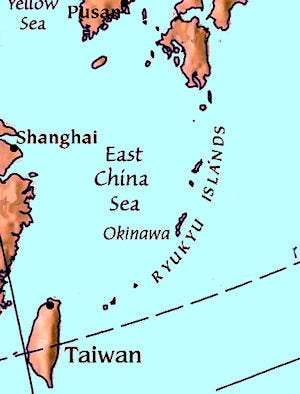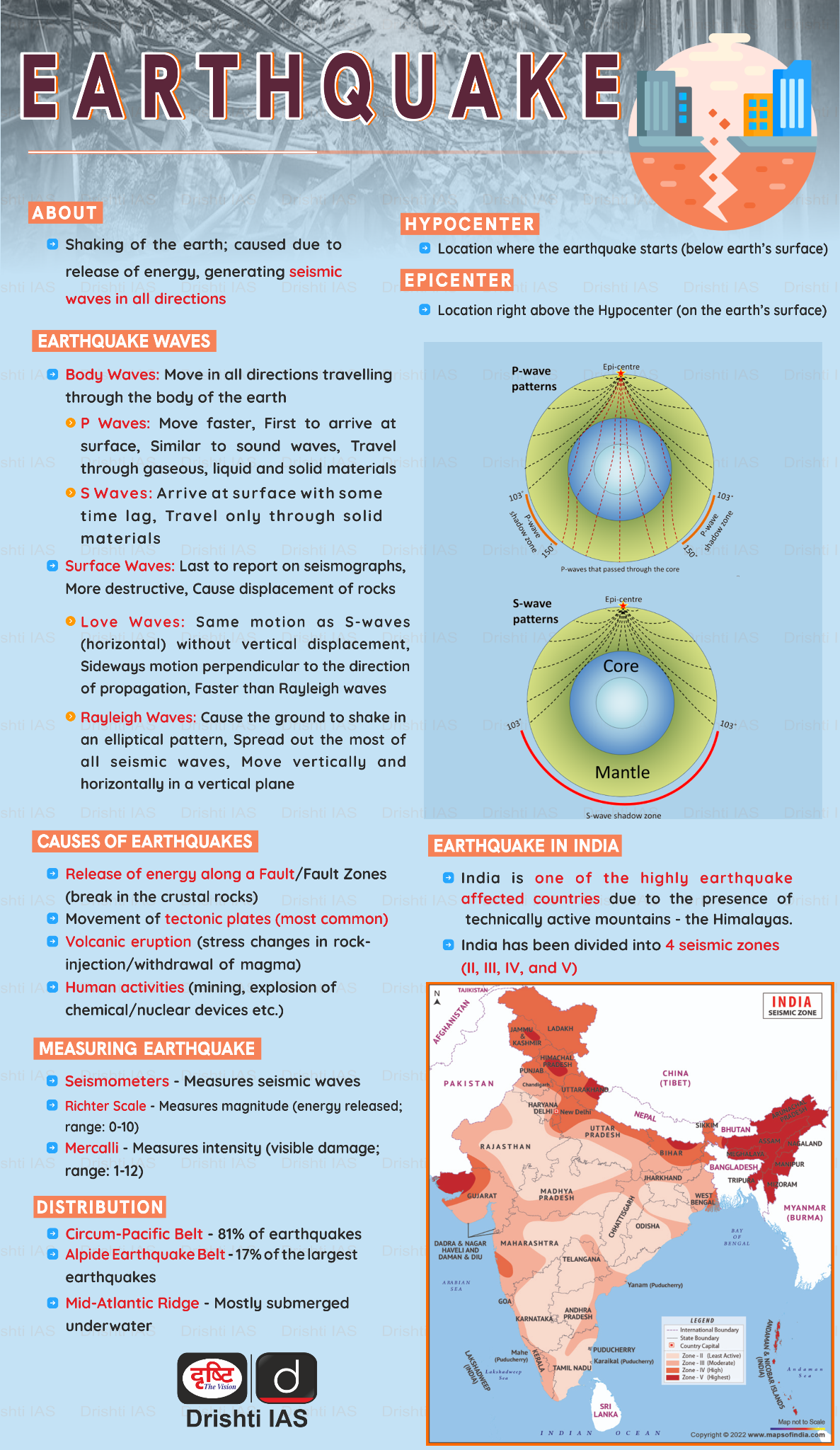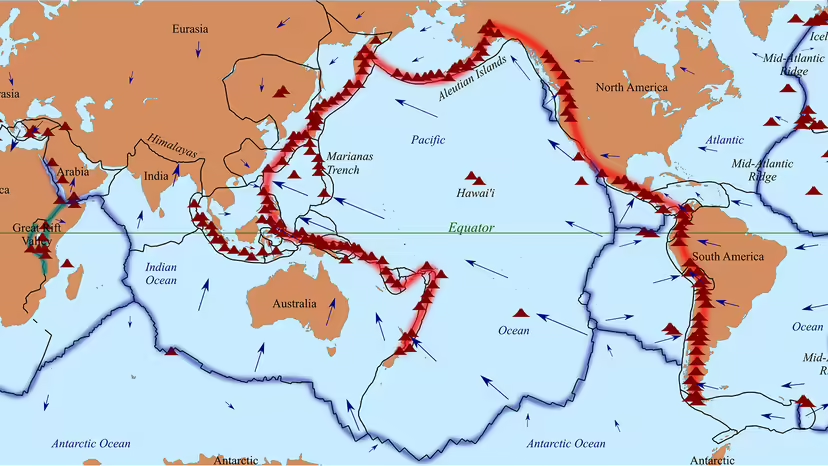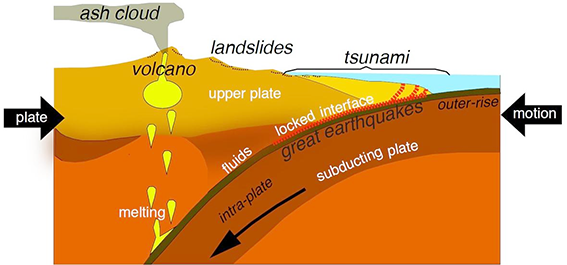Geography
Taiwan Earthquake and Pacific Ring of Fire
- 10 Apr 2024
- 8 min read
For Prelims: Pacific Ring of Fire, Circum-Pacific Belt, Subduction, Tsunami, Earthquake.
For Mains: Ring of Fire, Features and Causes of Frequent Earthquakes in the Pacific Ring of Fire.
Why in News?
A huge earthquake measuring 7.4 on the Richter Scale struck Taiwan, making it one of the biggest Earthquakes in at least 25 years.
- Japan issued a tsunami alert for the Ryukyu chain of islands which stretches from Taiwan to its main ‘home island’ of Kyushu. The Ryukyu group includes the island of Okinawa, which has been home to large US military bases since World War II and the Cold War.
What are the Causes of Such Earthquakes in Taiwan?
- Taiwan is prone to earthquakes as it lies along the Pacific “Ring of Fire” — where 90% of the world’s earthquakes take place.
- The Ring of Fire is the line of seismic faults encircling the Pacific Ocean where most of the world's earthquakes occur.
- The area is particularly vulnerable to temblors due to the tension accumulated from the interactions of two tectonic plates, the Philippine Sea Plate and the Eurasian Plate, which may lead to sudden releases in the form of earthquakes.
- Taiwan’s mountainous landscape can magnify the ground shaking, leading to landslides.
- Several such landslides occurred on Taiwan's eastern coast near the epicenter of when falling debris hit tunnels and highways, crushing vehicles and causing several deaths.
What is the Pacific Ring of Fire?
- About:
- Also called the Pacific rim or the Circum-Pacific Belt, is an area along the Pacific Ocean that is characterised by active volcanoes and frequent earthquakes.
- It is home to about 75% of the world’s volcanoes and about 90% of the world’s earthquakes occur here.
- Geographical Stretch:
- The Ring of Fire is stretched to approximately 40,000 kilometres tracing boundaries between several tectonic plates including the Pacific, Juan de Fuca, Cocos, Indian-Australian, Nazca, American, and Philippine Plates.
- The chain runs up along the western coast of South and North America, crosses over the Aleutian Islands in Alaska, and runs down the eastern coast of Asia past New Zealand and into the northern coast of Antarctica.
- There are several countries in the ring of fire like Indonesia, New Zealand, Papa New Guinea, Philippines, Japan, United States, Chile, Canada, Guatemala, Russia, Peru, Solomon Islands, Mexico and Antarctica.
- Causes of Volcanic Activity:
- Tectonic plates move towards each other creating subduction zones. One plate gets pushed down or is subducted by the other plate. This is a very slow process – a movement of just one or two inches per year.
- As this subduction happens, rocks melt, become magma move to Earth’s surface and cause volcanic activity.
- Recent Research:
- The Pacific Plate, which drives much of the tectonic activity in the Ring of Fire, is cooling off.
- The cooling process may alter the dynamics of plate boundaries, affecting subduction zones and mountain-building processes.
- Scientists have discovered that the youngest parts of the Pacific Plate (about 2 million years old) are cooling off and contracting at a faster rate than older parts of the plate (about 100 million years old).
- It could lead to increased stress accumulation along plate boundaries and may result in more frequent and potentially stronger earthquakes.
- The younger parts of the plate are found in its northern and western parts, the most active parts of the Ring of Fire.
- The Pacific Plate, which drives much of the tectonic activity in the Ring of Fire, is cooling off.
What is Subduction?
- Subduction happens when tectonic plates shift, and one plate is pushed under another. This movement of the ocean floor produces a "mineral transmutation", which leads to the melting and solidification of magma i.e., the formation of volcanoes.
- In other words, when a "downgoing" oceanic plate is pushed into a hotter mantle plate, it heats up, volatile elements mix, and this produces the magma.
- The magma then rises up through the overlying plate and spurts out at the surface.
- A subduction zone is the biggest crash scene on Earth. These boundaries mark the collision between two tectonic plates.
- When two tectonic plates meet at a subduction zone, one bends and slides underneath the other, curving down into the mantle, the hotter layer under the crust.
What is a Tsunami?
- Tsunami is a Japanese term meaning a harbour wave. It is also commonly known as killer waves.
- A Tsunami is not just a single wave but a series of ocean waves called a wave train caused by an underwater earthquake, by a volcanic eruption, landslide, rapid changes in atmospheric pressure, or a meteorite.
- However, tsunamis caused by volcanic activity are less frequent.
- Most tsunamis–about 80%–happen within the Pacific Ocean’s “Ring of Fire,” a geologically active area where tectonic shifts make volcanoes and earthquakes common.
- Tsunamis race across the sea at up to 800 kilometres an hour. At that pace, they can cross the entire expanse of the Pacific Ocean in less than a day.
- Since they are long wavelengths, they lose very little energy along the way.
- In December 2015, the UN General Assembly designated 5th November as World Tsunami Awareness Day.
|
Drishti Mains Question: Q. Discuss the causes, impacts, and mitigation strategies for earthquakes and tsunamis, highlighting the importance of early warning systems and community preparedness. |
UPSC Civil Services Examination, Previous Year Question (PYQ)
Prelims:
Q. Consider the following: (2013)
- Electromagnetic radiation
- Geothermal energy
- Gravitational force
- Plate movements
- Rotation of the earth
- Revolution of the earth
Which of the above are responsible for bringing dynamic changes on the surface of the earth?
(a) 1, 2, 3 and 4 only
(b) 1, 3, 5 and 6 only
(c) 2, 4, 5 and 6 only
(d) 1, 2, 3, 4, 5 and 6
Ans: (d)
Mains:
Q. Discuss about the vulnerability of India to earthquake related hazards. Give examples including the salient features of major disasters caused by earthquakes in different parts of India during the last three decades. (2021)
Q. Why are the world’s fold mountain systems located along the margins of continents? Bring out the association between the global distribution of fold mountains and earthquakes and volcanoes. (2014)











